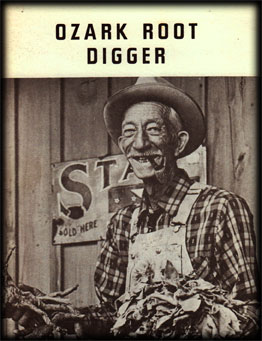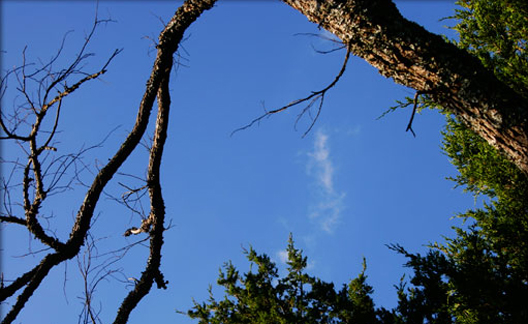Legend of the Yocum Dollars
from Chick Allen
The post-civil war Ozarks was a place far removed from the region we now know. Most think of the Ozarks today in terms of natural beauty, country music, fishing, summer traffic, Christmas lights.
But not long ago, the place was a battlefield. It is humbling to realize that the Ozarks of the late nineteenth century more closely resembled a war-torn third world nation than a civilized country.
And perhaps there's some inspiration therein.
Legend of Bread Tray Mountain
From Chick Allen
Many people have searched for the Lost Silver Mine of the Ozarks, believing it to contain a fortune of Spanish wealth and Indian jewelry. The fabulous cache of Yocum Dollars is also a mystery. And the making of these Yocum dollars is one of the strange legends of the Ozarks.
“The making of the Yocum Dollars is a strange legend.”
The story is true and dates from 1541, when Spanish explorers under the command of Coronado came to the Ozarks in search of gold. They build a fort atop Breadtray Mountain (at the junction of the James and White Rivers in Stone County). The legend says they mined silver from a cave close by. The Indians attacked and killed most of them. Those who survived sealed the cave with stones and never returned. In 1809, the cave was rediscovered when a band of Chickasaw Indians — caught in a bad thunderstorm — took refuge in the cave and found the walls to be almost pure silver.
“The walls were found to be almost pure silver.”
The Chickasaws worked in the mine making jewelry of silver and taking it to St. Louis and St. Charles to trade for supplies. They had so much jewelry that they made bars of silver and stored the treasure in a room of the cave. One day, fearing a band of Mexican gold hunters traveling up the White River, the Chickasaws sealed the cave entrance and moved westward. Soon the Indians were plagued with a disease called Black Rot and most of the band died. The survivors were not able to return to the cave for many years.
Sometime around 1826, a family from Illinois — the Yocums — headed for California, traveling in linch-pin wagons pulled by oxen. Reaching Springfield, Missouri, they met an old Indian who asked them to come to his home country on the James and White Rivers where the fishing and hunting were good and [there was] honey in the hollow trees. The family hired the old Indian to guide them to his land. By the time they had reached the James River, the Yocums had become good friends with the Indians and were treated as such.
Continued above right...
plate 1. a deceased hardwood and green cedars frame a summer sky. Photo credit, J. Heston. Location: Henning Conservation Area (Branson, Missouri), June 30, 2008.
Legend of Breadtray Mountain:
Breadtray Mountain is located near the junction of the James and White Rivers in Stone County, Missouri. The name comes from the early pioneer settlers who thought the mountain was shaped like a breadtray. Long ago, a band of Chickasaw Indians in the area of Breadtray Mountain discovered silver deposits and made crude jewelry which was used as a medium of exchange. This jewelry became so popular that the Chickasaws used a cave under the mountain as their workshop — and as a safe place to hide the silver.
They worked for several years until an enemy tribe forced them to leave the region. Before leaving, they hid their treasures in a secret passage of the cave and sealed the entrance. They never returned and the legend goes that somewhere behind the walls lies the vast treasure of the Chickasaw. Another legend took place when, in the latter part of the 19th century, the notorious Bald Knobber gangs operated in Stone and Taney Counties. It is said they used the cave under Breadtray Mountain as a base for their operations and that they hid their loot there.
In 1869, the entire gang was captured and executed — except for one man. He escaped from jail at Ozark, Missouri, and fled the country. Old-timers figured he returned to the cave and recovered the loot.
— Chick Allen

plate 2. These stories were first written and published by Chick Allen in 1975.
Pictured below, Allen is remembered as an Ozark historian and “root digger” a founding member of the Baldknobber Music Show, and, perhaps most importantly, as a deeply respected and loved father and grandfather.
It is with great appreciation to John Fullerton — Chick Allen's great grandson and Branson historian — that this excerpt is published.
Breadtray (Continued):
The Indians all wore strings of beads, rings and ornaments made of silver. The family from Illinois questioned them and found they got the silver from a cave but would not tell the location until 1835, when the Government started to move them out of the country.
It was then the Indians traded the location of the silver cave for horses and supplies. The Yocums began to mine the silver. They would ride away for two or three days and then return with silver bars and jewelry, refusing to tell the location of the cave.
As new settlers arrived in the White River Ozarks, the need for a monetary medium of exchange grew. Physical money was scarce and the family decided that the silver would answer the problem.
With blacksmith tools, they formed a mold with "Yocum Dollar" inscribed. Everything was going good until the Government surveyors moved in to lay out the county lines. Settlers, including the Yocums, were told that to keep their lands, they must homestead and pay a filing fee in a land office in Springfield. About six men went there to pay their fees and were told their money was counterfeit. The land office would not accept their "dollars" as payment.
These "hillbillies" told the Government they were not leaving without a title to their land. They were so rough about it that the Government man agreed to send the Yocum Dollars to Washington and wait for the outcome. Word came back that the dollars were almost pure silver. The Government also instructed the land office to gather up all of the silver coins, find out where the cave was located and not homestead the land to anyone.
Later a Government man came to the Yocum's home, wanting to inspect the mine. The Yocums told him to get out of the country and never come back. He returned eight years later with eight men and the argument was settled:
The family would quit making the Yocum Dollars but would not tell where the mine was located
Later, the men of the Yocum family went to the California gold fields and were never heard from again.




